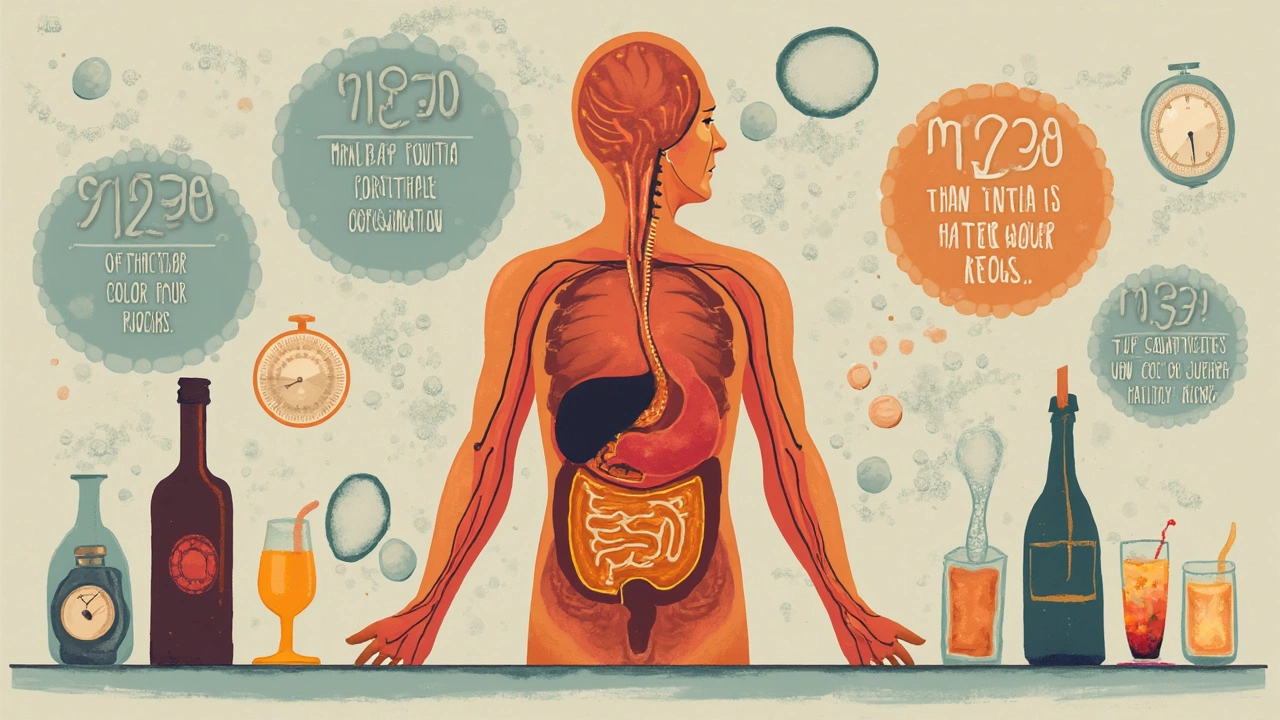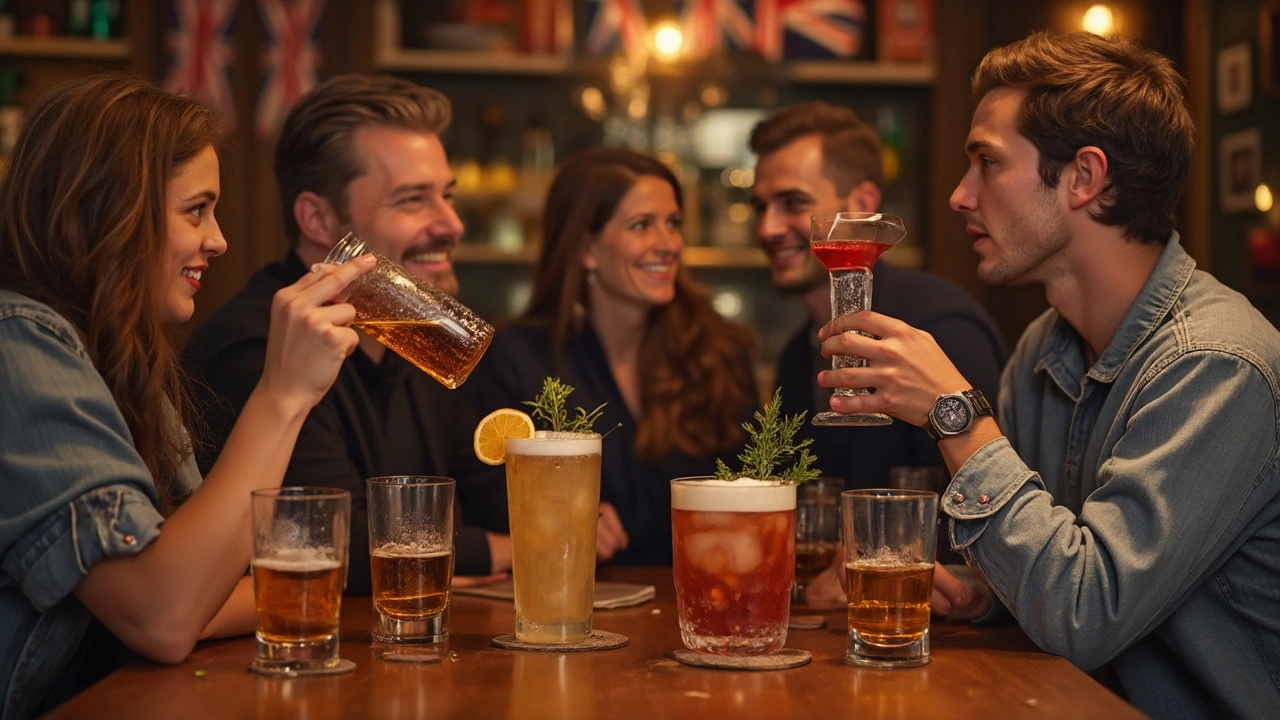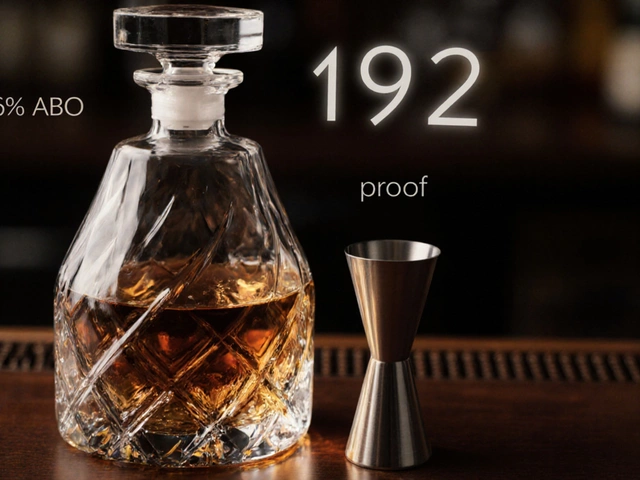If you’ve ever wondered why a couple of shots can hit you way faster than sipping two beers, you’re not imagining things. The kind of drink you choose isn’t just about taste—it can totally change how quickly you get drunk. It all comes down to alcohol content, how your body absorbs it, and some sneaky factors like mixers and bubbles.
Grabbing a spirit over a beer isn’t just a question of looking tough at the bar. Things like rum, vodka, or tequila usually have way more alcohol by volume (ABV) than wines or beers. That means less liquid can have a way bigger effect—sometimes surprisingly fast.
But the speed at which you feel tipsy isn’t only about the numbers on the bottle. Ever noticed that a fizzy vodka soda hits different than a flat glass of whiskey? Or that slamming shots feels way different from nursing a cocktail? Turns out, stuff like carbonation, mixers, and how fast you drink all play a role too.
- The Science of Getting Drunk
- Alcohol Strength: Not All Drinks are Equal
- Mixers, Bubbles, and Tricks That Speed Things Up
- How Serving Style Changes the Game
- Smart Tips for Safer Drinking
The Science of Getting Drunk
Ever wonder why the same drink can hit people so differently? Getting drunk isn’t magic—it’s all biology and a bit of math. When you gulp down alcohol, it goes straight to your stomach and small intestine. From there, it heads right into your bloodstream. That’s where the buzz starts, and also why the kind of drink you pick changes how fast it all happens.
Your liver is on clean-up duty, breaking down the alcohol. But it can only handle about one standard drink per hour. If you go faster than that, the extra booze builds up in your blood and, yep, you get drunk quicker. Here’s what counts as a standard drink in the US:
| Type of Alcohol | Serving Size | Approx. ABV |
|---|---|---|
| Beer | 12 oz (355ml) | 5% |
| Wine | 5 oz (148ml) | 12% |
| Spirits (Vodka, Whiskey, Tequila, etc.) | 1.5 oz (44ml) | 40% |
So, taking a fastest drink shot means your body gets hit with a chunk of alcohol in seconds. A beer takes longer to sip and digest, so the effect builds more slowly.
But there’s more to it. Your body size, food in your stomach, and even your gender make a difference. Folks with less body water (like women, on average) or those who drink on an empty stomach process alcohol quicker—so the feeling hits them harder and faster.
- Fatty or heavy meals slow down alcohol absorption.
- Sipping vs. chugging totally changes your blood alcohol spike.
- Genetics and even some medicines can make alcohol last longer in your system.
Bottom line: the science behind getting drunk fast is less about the drink’s flavor and more about how much and how quickly the alcohol gets into your bloodstream. Next up, let’s look at which drinks actually carry the most punch per ounce.
Alcohol Strength: Not All Drinks are Equal
Here’s where things get real: spirits, beer, and wine are absolutely not in the same league when it comes to how much alcohol they pack. This is where the fastest drink to get you drunk starts to show.
Let’s look at some real-world numbers—the typical alcohol by volume (ABV) for common drinks:
| Drink | Average ABV (%) | Standard Serving Size (ml) | Total Alcohol (ml) per Serve |
|---|---|---|---|
| Beer | 5% | 355 (12 oz) | 17.8 |
| Wine | 12% | 150 (5 oz) | 18.0 |
| Vodka, Rum, Whiskey | 40% | 44 (1.5 oz shot) | 17.6 |
This table shows that a shot of spirits, a glass of wine, and a bottle of beer all deliver about the same punch—if you go by the numbers. But it’s not just about total alcohol; it’s how quickly you drink it. Shooting a 1.5-ounce shot takes a second. Sipping a beer or wine takes much longer, so the alcohol gets spaced out in your system.
Don’t just take my word for it. According to the National Institute on Alcohol Abuse and Alcoholism:
“A standard drink contains roughly 14 grams of pure alcohol, but how quickly you drink it and what you drink makes a huge difference in how fast you feel it.”
Another thing—craft cocktails or mixed drinks can sneak in two or even three shots of spirit, which means some cocktails have double or triple the alcohol of a typical beer. Ignore the fancy glass: a Long Island iced tea or a strong margarita will skyrocket your BAC compared to a single beer.
- If your main goal is to feel it fast, straight spirits or cocktails with little mixer (like a classic martini) will work quicker than beer or wine.
- Light beers and wine coolers land way below the heavyweights—don’t expect to get buzzed fast drinking those.
- Watch for serving size: a pint of IPA or a double pour of whiskey delivers a whole lot more alcohol than the basics above.
Bottom line? Not all drinks are created equal, and paying attention to ABV and serving size is your shortcut to knowing what’ll get you there fastest.

Mixers, Bubbles, and Tricks That Speed Things Up
This is where things get sneaky. Your choice of mixer can totally turbocharge how fast you feel a buzz. Here’s the deal: sugary sodas, juices, or other sweet mixers can actually slow down how quickly your body absorbs alcohol. On the flip side, adding bubbles—think tonic, club soda, or champagne—does the opposite. Carbonation makes your stomach push liquids through to your small intestine faster, where alcohol gets picked up and put into your bloodstream. That’s why you might notice that vodka soda or rum and coke hitting you harder, and first timers often get caught off guard.
Let’s break down the main things that spike the speed:
- Fastest drink usually combines a high-alcohol spirit with a carbonated mixer. Think whiskey with ginger ale, or tequila with tonic.
- Taking your drinks as shots—straight, fast, and no ice—sends alcohol to your system in one punch, with nothing to slow it down.
- Warm drinks actually get absorbed faster than cold ones, though most folks don’t notice the difference unless you’re double-fisting hot sake all night.
- Not eating before drinking? That means the alcohol is working on an empty stomach, making the effects way more intense and way quicker.
- Drinking through a straw seems like a harmless move, but some people swear it speeds things up, too—though science is iffy on that one.
If you want to feel in control, watch what you mix and maybe slow down with plain water in between. But if your goal is to find which combo gets you feeling tipsy the fastest, spirits mixed with fizzy drinks are the clear winner. Just remember: going fast might sound fun, but it gets messy quick—so pace yourself.
How Serving Style Changes the Game
How you actually drink your booze really messes with how drunk, and how quickly, you get. It’s not just about what you drink, but how it’s served and how you put it away.
Let’s put it simply: drinking a shot is not the same as nursing a cocktail or sipping a highball. With shots, you send a big hit of alcohol straight to your stomach all at once. Your body has to process a lot of alcohol in a tiny window, so your blood alcohol rises fast. That’s why slamming back tequila can make you feel tipsy way quicker than slowly enjoying a gin and tonic, even with the same amount of booze overall.
Here’s what the different serving styles actually do:
- Shots: Fastest way to feel it. You’re delivering a high dose of alcohol in seconds. Your system doesn’t have time to adjust, so your BAC (blood alcohol content) spikes quickly.
- Sipping neat or "on the rocks": Slower uptake. You naturally pace yourself, giving your body time to catch up.
- Highballs and mixed drinks: More liquid means you’ll probably drink slower and the mixer dilutes the booze, slowing the effects a bit.
- Beer or wine: Lower ABV, but servings are bigger. These are usually sipped over 20-30 minutes, so the kick comes on more gradually.
Now, check out how drink styles compare for how fast they boost your BAC:
| Serving Style | Usual Drink Size | ABV (%) | Usual Time to Finish | Estimated BAC Rise* |
|---|---|---|---|---|
| Shot (e.g., vodka, tequila) | 1.5 oz | 40% | 5-10 sec | Fast, sharp spike |
| Mixer/Cocktail (e.g., gin & tonic) | 5 oz (with mixer) | 10-20% | 10-30 min | Moderate, steady climb |
| Beer | 12 oz | 4-7% | 15-30 min | Gradual rise |
| Wine | 5 oz | 12-15% | 15-30 min | Steady, slightly faster than beer |
*Estimated BAC rise depends on your weight, sex, and what you’ve eaten, but the pattern holds.
That’s why bars push shots for fast effects, while fancy tastings use small pours for slow sipping. If you want the fastest drink to get you tipsy, you’re looking at straight shots—no contest. But if you want to actually taste what you’re drinking and stay on your feet, slow down and switch up the serving style.

Smart Tips for Safer Drinking
Getting drunk fast can sound fun in theory, but let's get real—no one enjoys losing control or waking up to regret. Even if you’re on the hunt for the fastest drink to get you buzzed, it pays to know how to handle your night smartly so you’re not that person in the group chat the next morning.
One killer fact: your liver can only process about one standard drink per hour. You're not going to outsmart biology—anything extra just stacks up, waiting its turn. According to the Centers for Disease Control and Prevention (CDC), binge drinking typically means having 5 or more drinks for guys, 4 or more for women, within about two hours. That’s when people get into trouble fast.
"The effects of alcohol hit quicker and last longer than most people realize—pace yourself, and don’t trust myths about ‘soaking up’ booze with food after the fact." — National Institute on Alcohol Abuse and Alcoholism (NIAAA)
Some basic moves can save your night and your head:
- Eat a decent meal before you start drinking (think carbs and protein, not just fries).
- Alternate drinks with water. Hydration helps keep your buzz manageable and your body a lot happier.
- Steer clear of chugging shots—spreading drinks out really does make a difference. Your liver will thank you.
- Know what you’re actually sipping. Some cocktails are basically two or three drinks in one glass.
- Watch the bubbles—carbonated drinks like champagne or mixers make your body absorb alcohol faster.
Here's a quick breakdown of how long some common drinks take your body to process. Remember, this is per standard serving, not per glass (that margarita might count as two!):
| Drink | Standard Serving Size | Avg. Processing Time |
|---|---|---|
| Beer (5% ABV) | 12 oz (355 ml) | 1 hour |
| Wine (12% ABV) | 5 oz (148 ml) | 1 hour |
| Spirits (40% ABV) | 1.5 oz (44 ml) | 1 hour |
At the end of the night, the best move is to check in with yourself often. Feeling dizzy? Slow down or switch to water. Remember, you’re out to have a good time, not just to see who can finish first. Smarter drinking means you stay in control, actually enjoy the night, and remember the fun in the morning.


